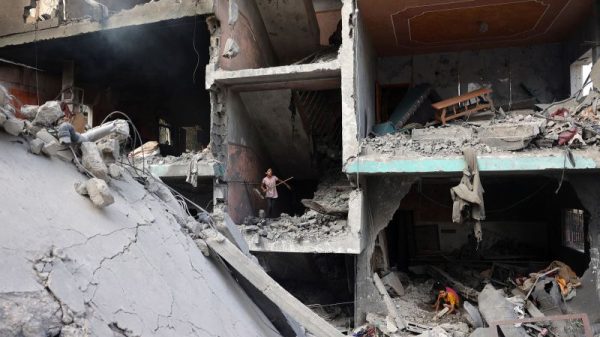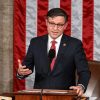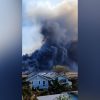Rare demonstrations continued for the 11th day in Syria’s southwestern city of as-Suwayda on Wednesday, an area populated predominantly by the Druze minority, with residents decrying poor living conditions and demanding regime change.
The protests, which are taking place in areas governed by President Bashar al-Assad’s regime, have so far shown no signs of abating. Unusually, security forces have refrained from cracking down as hundreds of people took to the streets, according to videos on social media, observers and local reports.
The unrest shows that disgruntlement against Assad remains high as he tries to end his international isolation, even in parts of the country that haven’t directly opposed him throughout its long civil war. The Druze are Syria’s third largest religious minority making up 3% to 4% of the country’s population, according to Minority Rights Group International.
While some Druze chose to align themselves with either side of the civil conflict, most have avoided doing so, and many have refused to enlist in Assad’s army.
The protests “come at a particularly dynamic time and serve to underline just how vulnerable and unsustainable Assad’s rule has become,” said Charles Lister, director of the Syria program at the Middle East Institute in Washington, DC. He added that while the president has for years relied on the support or neutrality of Syria’s minorities, the fact that the Druze of Suwayda are leading the protest movement now indicates “an acute threat” for the regime.
Isolated for more than a decade since the 2011 Arab Spring uprisings morphed into a bloody civil war between his regime and rebels who sought to depose him, Assad eventually regained control of most of the country with the help of allies Russia and Iran, with a northern strip still controlled by rebel forces.
The UN has said that more than 300,000 civilians have been killed since the conflict broke out, some 1.5% of Syria’s pre-war population. Millions of others have been displaced. Despite efforts to hold Assad accountable for the losses, in May he was welcomed back into the Arab fold in a move opposed by Western states and many of the refugees who fled persecution under his rule.
The strongman nonetheless hopes his re-admission into the Arab League will open doors to the international community, and even the lifting of crippling Western sanctions.
In videos shared on social media, protesters are seen waving the Druze flag and chanting, “Long live Syria and down with Bashar al-Assad.”
Rayan Marouf, editor of the local Suwayda 24 news website, said that demonstrations in recent days have spanned across several villages in Suwayda governorate and attracted hundreds of people.
He added that protesters in recent days have also shut the headquarters of the ruling Baath party, which came to power in Syria through a 1963 coup, and which Assad currently heads.
Social media videos also showed protests last week in the southern city of Jaramana, just 12 kilometers (7.5 miles) from the capital Damascus.
“That was the first time we have seen protests in Jaramana, which has always been known to be a city supportive of the regime in 2011,” Marouf said, adding that there have also been protests in rebel-held areas such as Idlib and Aleppo.
Residents in coastal cities inhabited by Assad’s minority Alawite sect, who had supported the president and his father Hafez since the 1970s, have begun criticizing the regime on social media platforms, according to Marouf, and social media posts.
A bad economic situation
Despite Syria’s re-admission into the Arab League, its economy has continued to freefall.
The UN’s Special Envoy for Syria, Geir Pedersen, last week told the UN Security Council that the latest indicator of suffering for the country is “the further collapsing economy.”
“A very bad economic situation has got even worse” with every community in the country being affected, Pedersen said, adding that in some three months, the Syrian pound has lost over 80% of its value.
The envoy added that the prices of essential goods, including food, medicine, fuel and other basic commodities, are spiraling out of control. And while the government has taken measures to double minimum state salaries, they are not enough to address the current dire circumstances.
Assad has repeatedly blamed Western sanctions for the economic collapse.
In an interview with Sky News Arabia this month, he insisted that the war was a foreign conspiracy against his country, adding that there wasn’t significant domestic opposition to his rule. He didn’t show remorse for the policies that led to the war and the ensuing destruction and loss in human life. “If we go back in time, we will build and adopt the same policy,” he said.
He did however acknowledge that living conditions for Syrians remain dire. “How can a refugee return without water, electricity, schools for his children, and no medical treatment? These are the basics of life,” he said.
Restrained security forces
While the city of Suwayda has witnessed less intense fighting during the civil war, it became a target of a series of coordinated attacks by ISIS militants against the Druze in 2018. The assault killed more than 200 people, and further fueled tensions between Suwayda’s residents and the regime for failing to protect them.
Today’s protests are nonetheless unusual, mainly due to the regime’s restraint from using violence.
Last year, when demonstrators in the same city stormed the governor’s office during protests over economic conditions, clashes broke out with security forces and an exchange of gunfire killed two people.
“Security forces seem to be trying to contain things without sparking clashes, this is very clear from how authorities are behaving, at least so far,” Marouf said. “The Syrian regime today is aware that any violent response to protesters will trigger a whirlpool of unprecedented violence in Suwayda.”
Lister of the Middle East institute said that while Assad has so far acted with restraint, the threat of violence still remains, especially if the protests spread.
This is “a reflection of the challenge posed more than any change in mentality,” Lister said. “If protests spread deeper into regime territories, those chances (of violent crackdown) will surge.”
All eyes are on Assad’s next moves. The president was invited by United Arab Emirates, the COP28 host, to attend the UN’s Climate Summit this year, which will take place from November 30 in Dubai. If Assad attends, it would be his first appearance on the world stage since the start of the civil war in 2011.
“For those of us who remained deeply skeptical of normalization, everything happening right now is further evidence of what should have been clear all along: Assad is not the solution to Syria’s chaos and suffering, he is the cause,” Lister said.







































